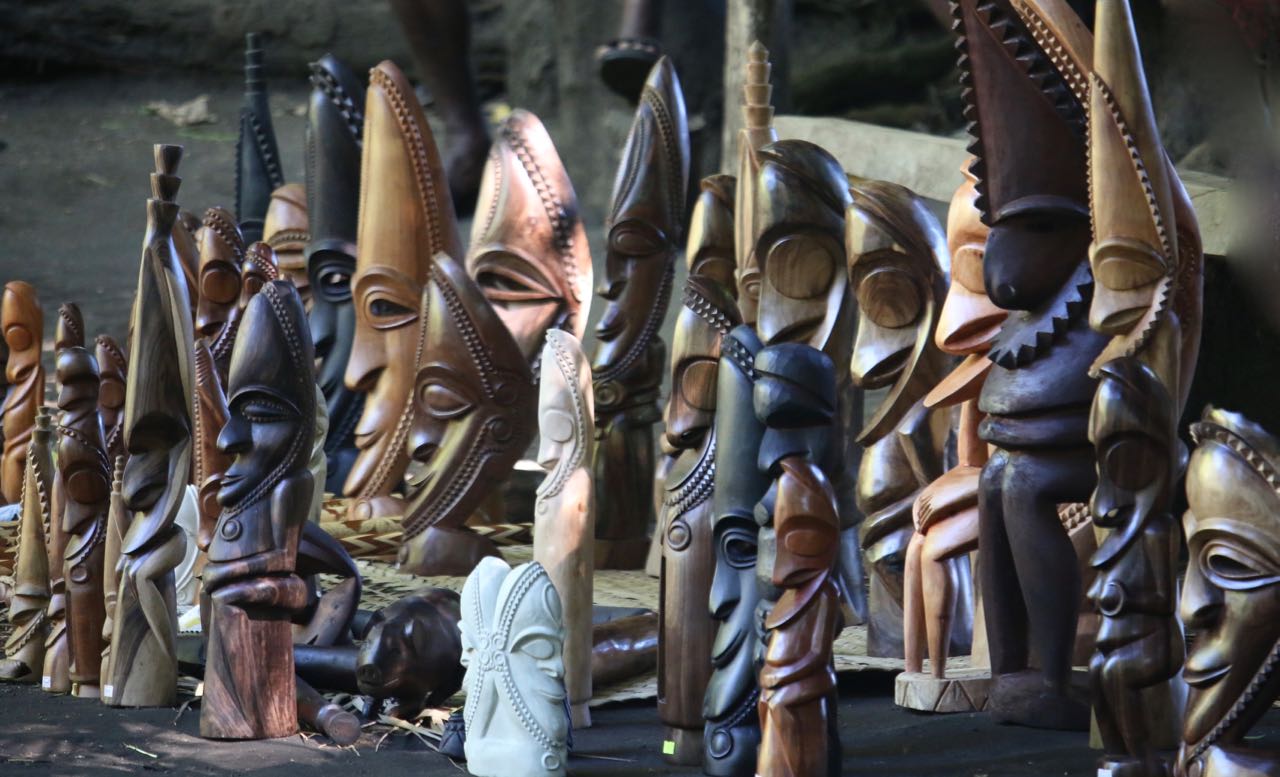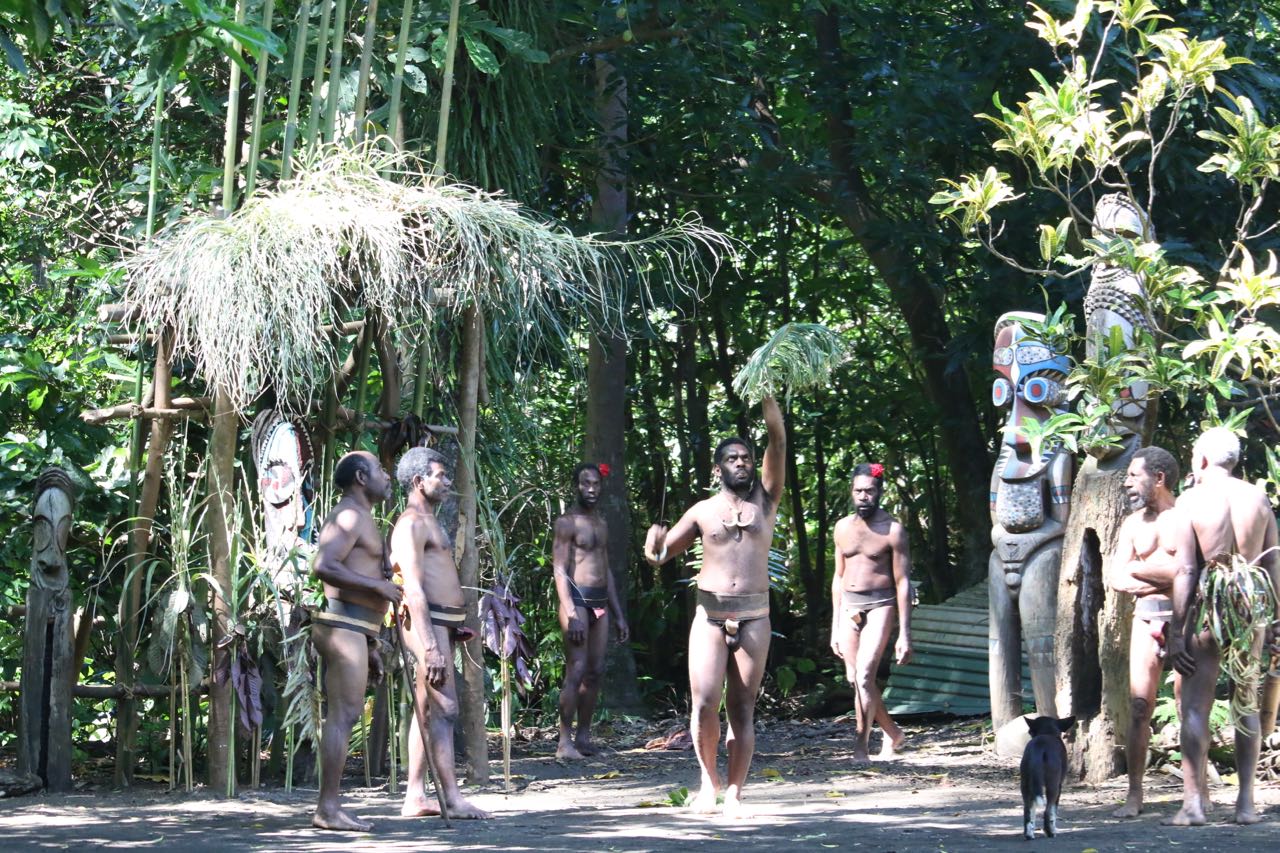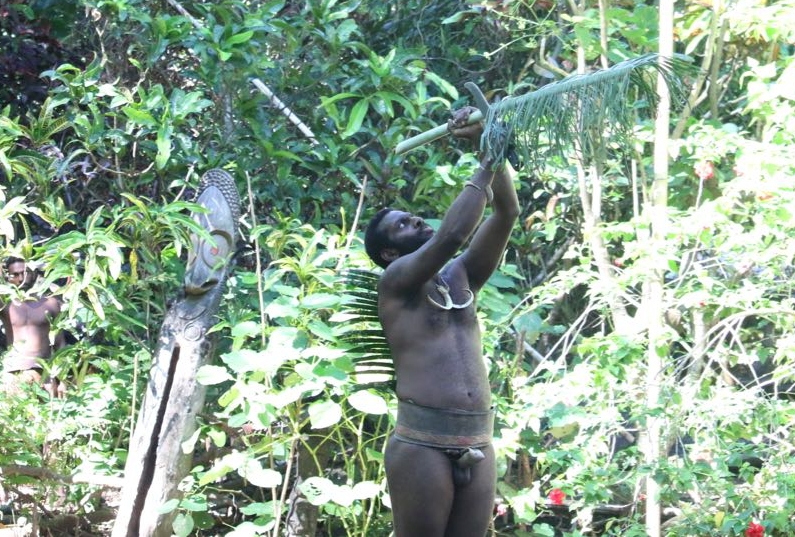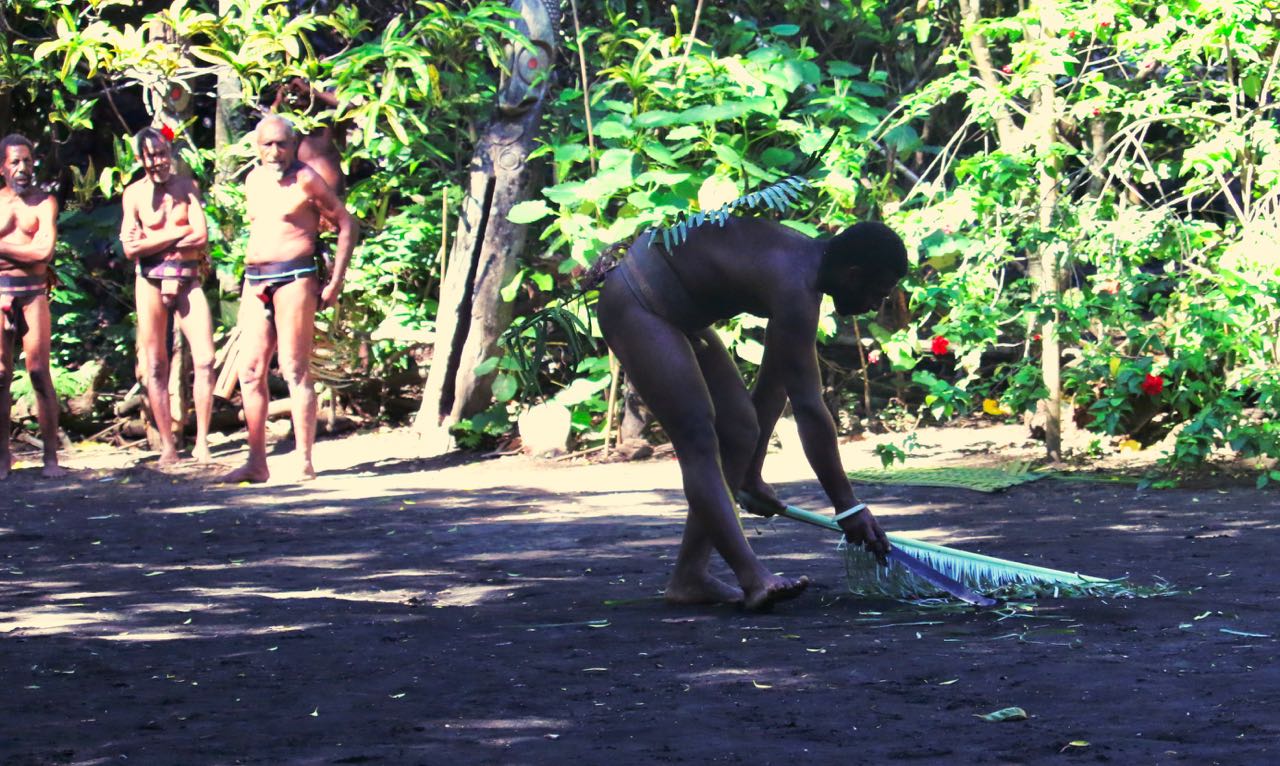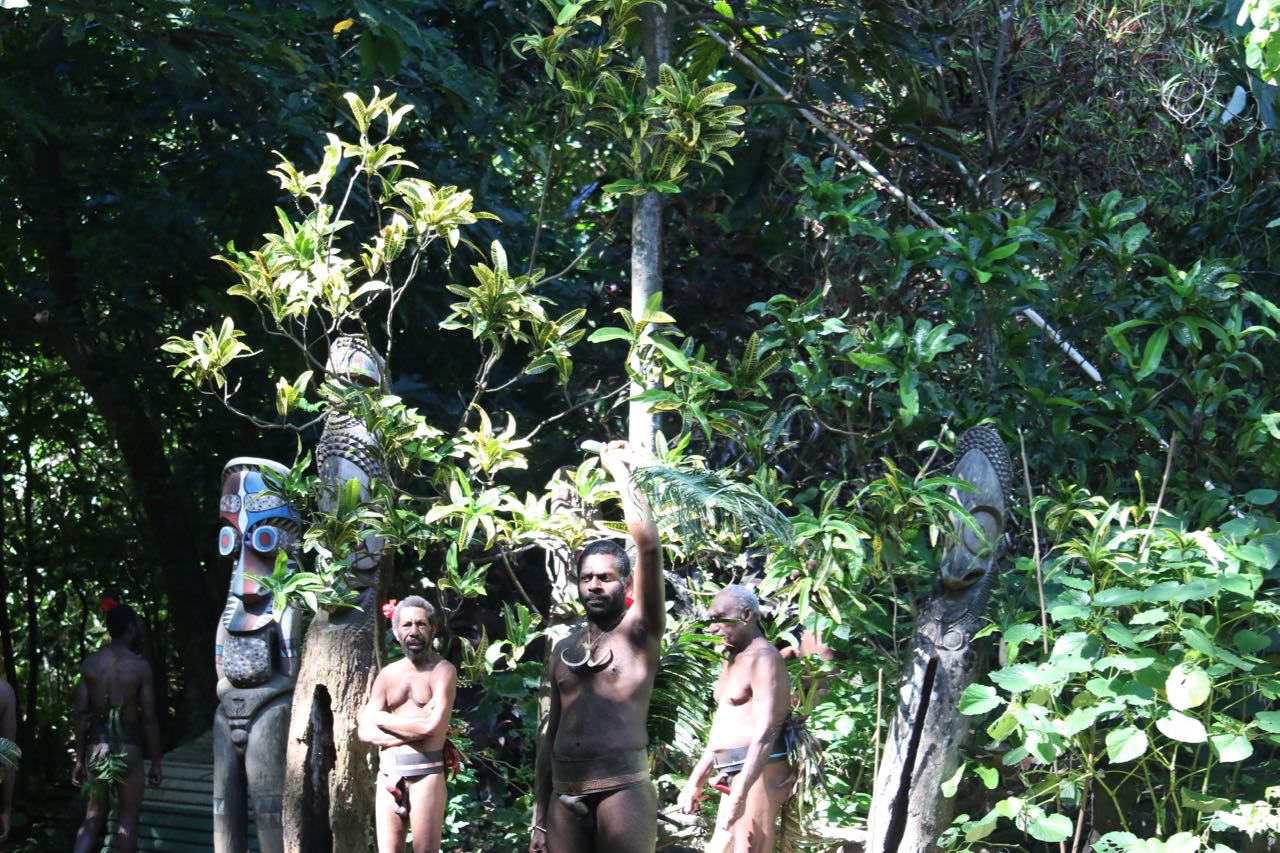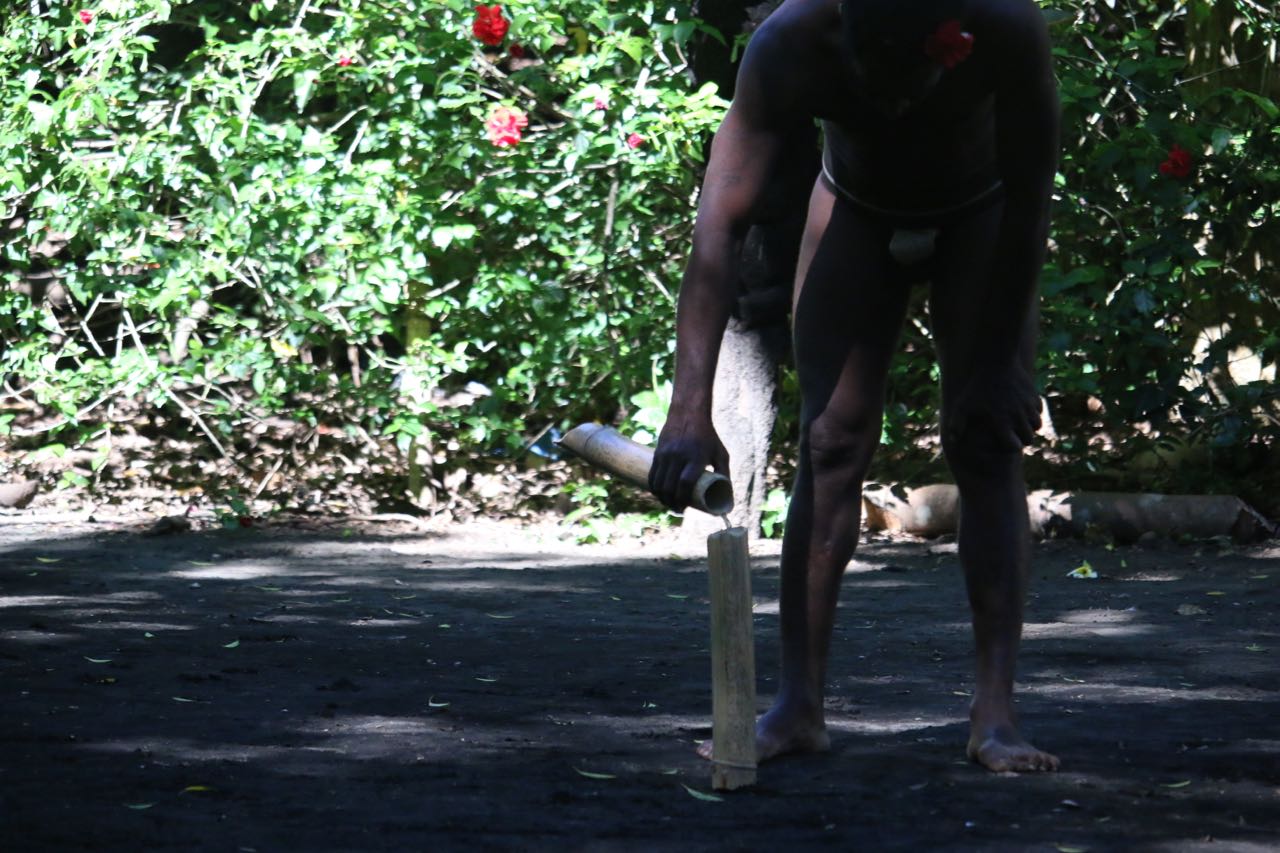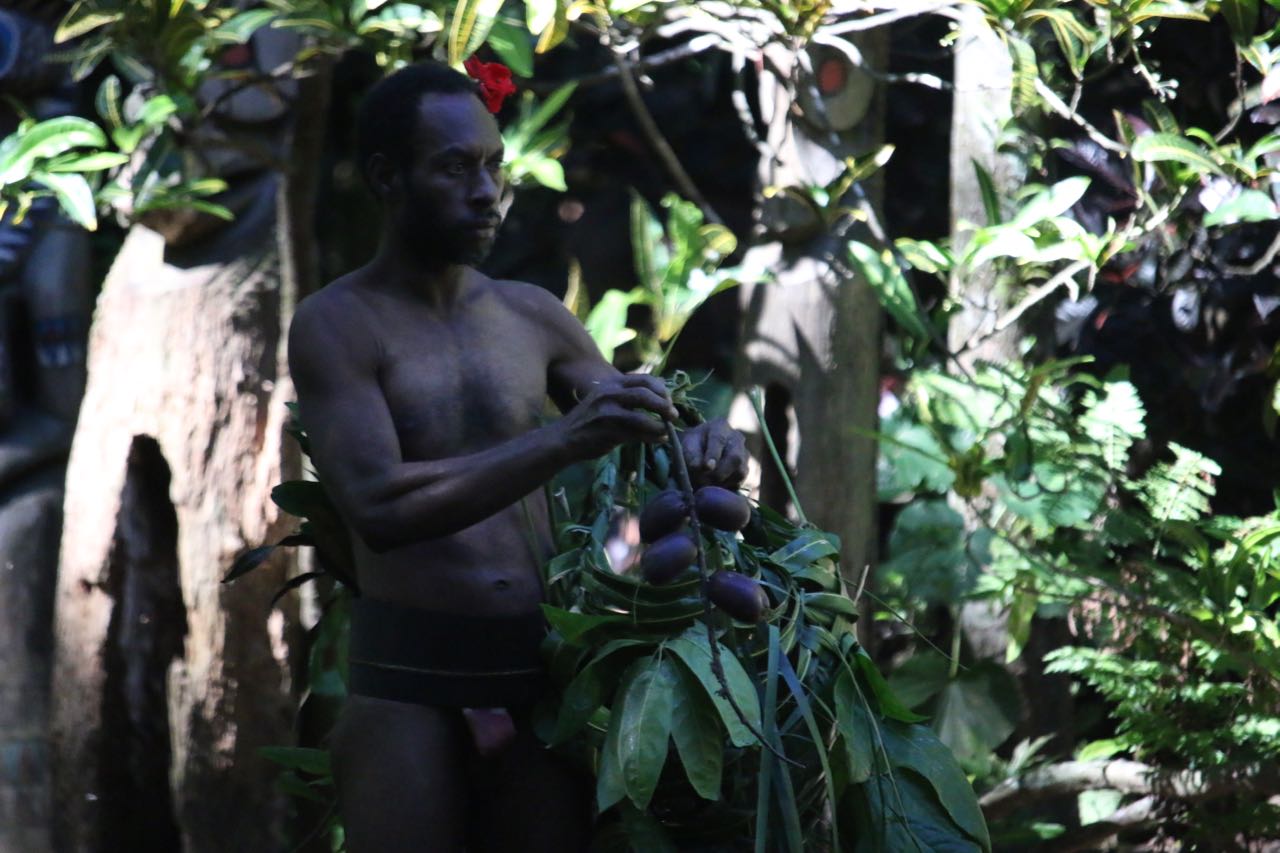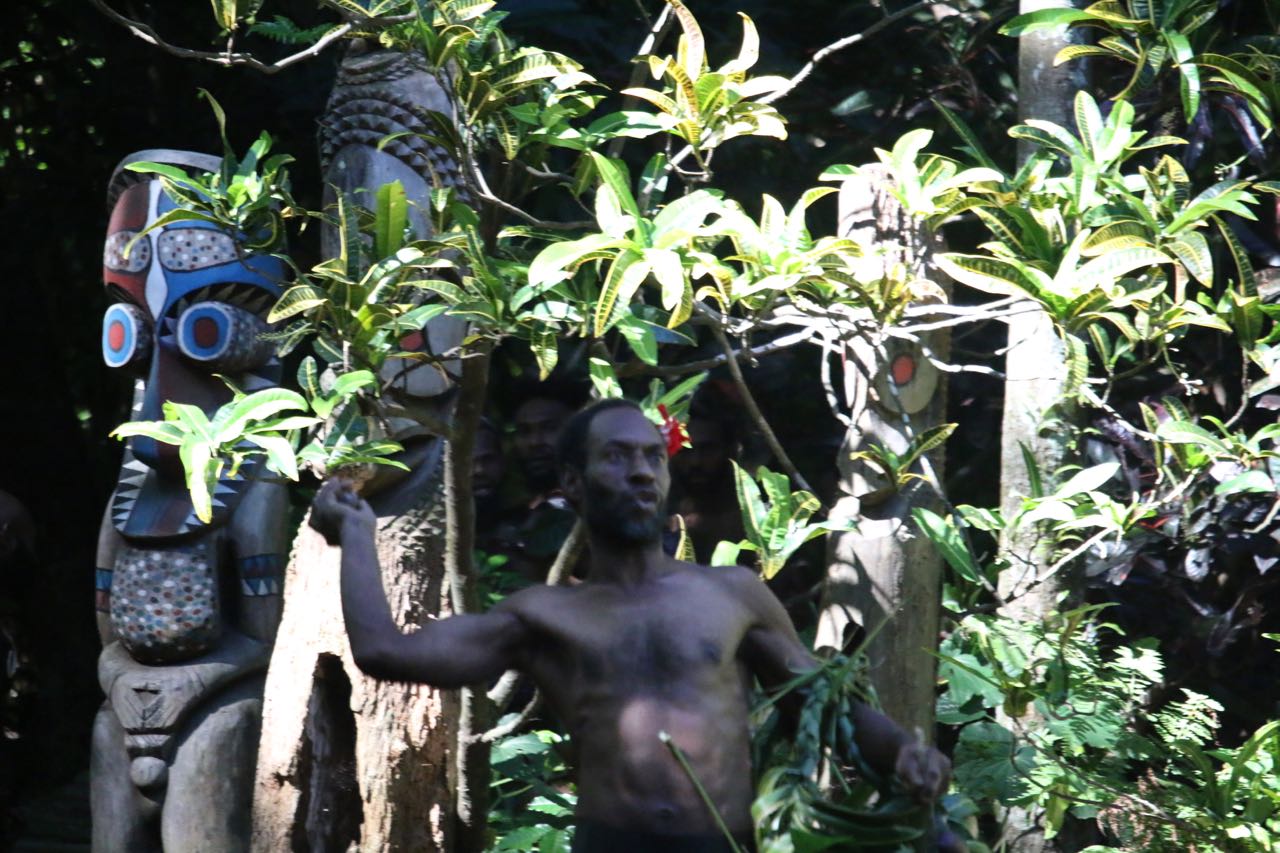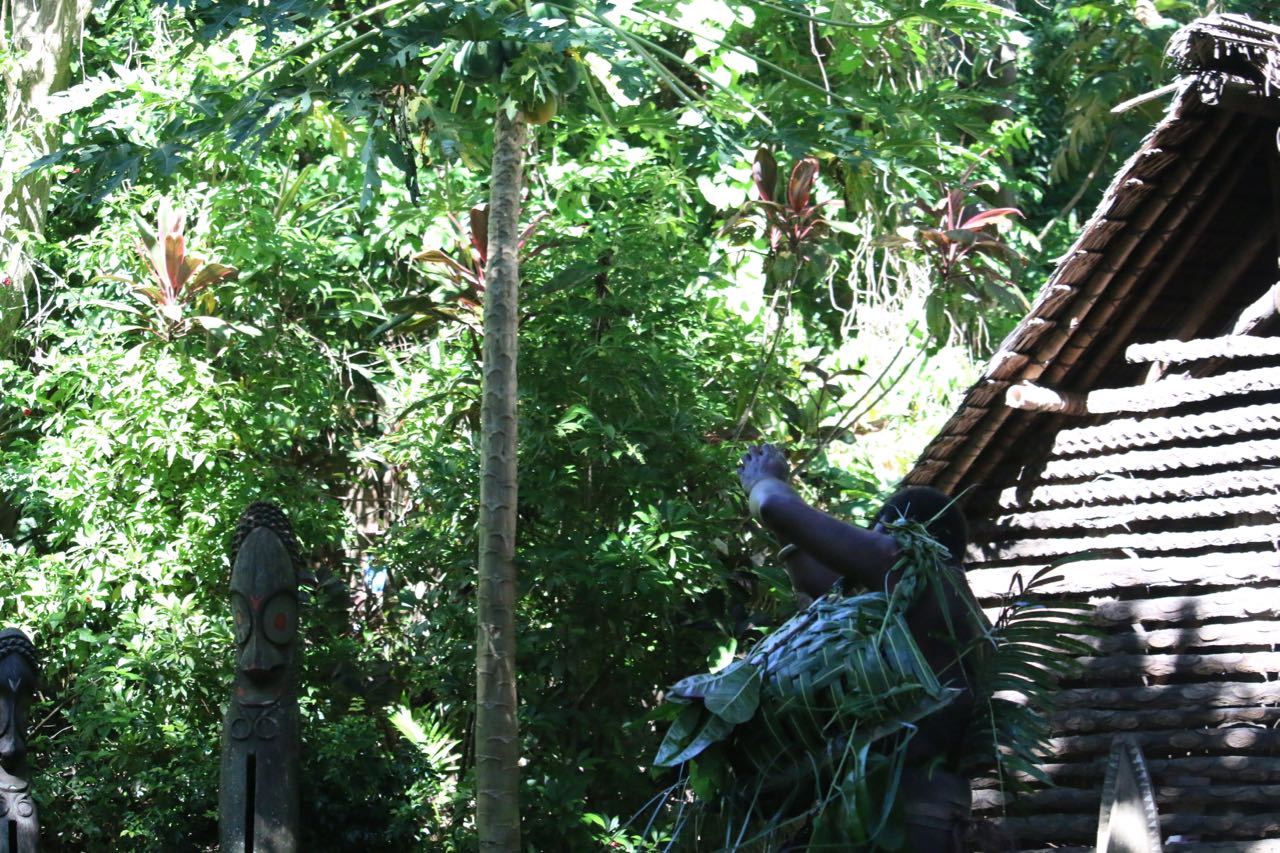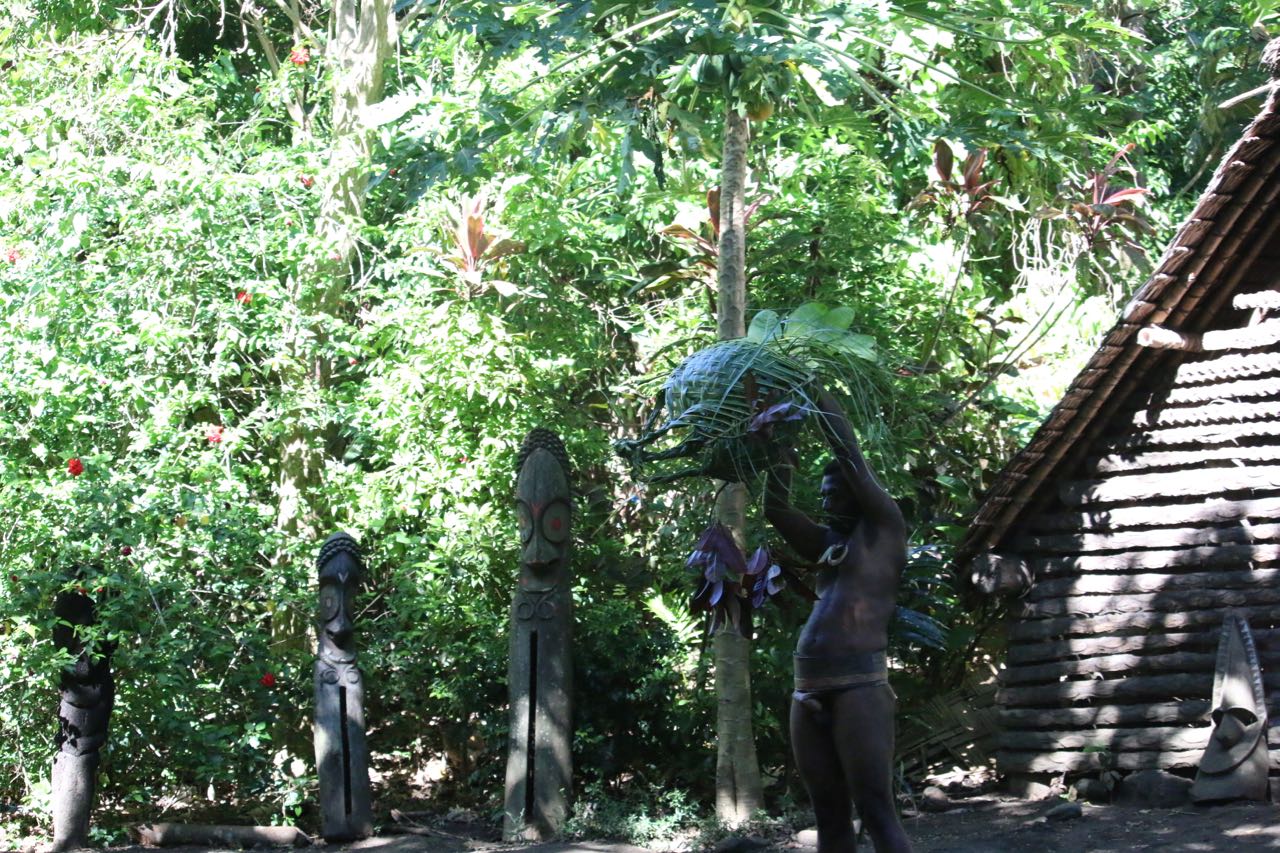At least according to its inhabitants, Ambrym received its name as a result of its first trade with the western world. One day, the chief of Fanla made a journey from his village in the mountain hillside to the village of Ranon on the shoreline. The chief’s daughter had recently married a Ranon son, and the chief paid her a visit to make a trade. In return, the Ranon village gave the Fanla Chief one of their giant yams. Carrying the giant yam over his shoulder, the Fanla Chief walked along the shoreline until he was about to turn right and head up the ridge. There, on the beach, he encountered none other than Captain James Cook toting a gun and dressed in his British finery. As reported, the Chief feared for his life. Thinking there was no other way to make peace, he offered Captain Cook the recently acquired yam. Stretching out the yam toward Captain Cook, the Chief says “Am Rym!” ceremoniously giving the “R” a long trill. A phrase meaning, “your yam” or in other words "a yam for you!”
Captain Cook graciously took the yam, but misunderstood. Believing the Chief was welcoming him to the island of “Ambrym,” Captain Cook scribbled the name Ambrym on his charts. Not to worry, though. Captain Cook returned the favor of the yam with a trade of his own, allegedly leaving a ceramic smoking pipe and a iron axe.
Sitting in the secret-sacred place, William retells this story with much pomp and ceremonial honor. The Chief displays the Iron Axe and his right hand man displays the smoking pipe. A gasp circulates amongst the village when he inadvertently drops the smoking pipe. A second right hand man emerges from the nearby hut carrying this year’s prize yam. Not THE yam that was given to Captain Cook, of course, but one just like it. Is it any wonder Captain Cook named this Island “Your Yam”?
We are taken to see the grave of the Chief who met Captain Cook.
Trust me, it's in there. This is a jungle, people.
I cannot confirm the veracity of this Captain Cook story, nor whether it is actually is his smoking pipe. What I can confirm is that these people are serious about their trading. We heard trading of goods in the South Pacific is common, but it hasn’t been a major part of our experience. At least not until we reached Vanuatu. It wasn't long after arriving here that a bundle of coconuts landed on Sonrisa’s deck. A beautiful smile and a warm welcome later, we were given an invitation to come ashore to choose more food from the village garden. Food is always the first trading overture.
Once the offer of food is made, you don’t have to reciprocate immediately, but you must reciprocate. Don’t be fooled, this is a test of your character. As it was explained to us: “Here, being tight fisted is worse than being mean.”
A bunch of bananas for a gallon of gasoline. A bundle of coconuts for a tea pot filled with fresh RO water. A traditional dinner in the village for a lunch on your sailboat. A trip to see the giant clams in exchange for $5.00 donation and a “new to them” pair of shorts. A tour of the village in exchange for a disk filled with photographs of the people you took pictures of. Your hair will be braided in exchange for sharing a pack of Oreos with the group. We will sing a song for you, if you will sing a song for us! Grapefruit for a bag of sugar. Sardines for a box of matches. A cup of kava in exchange for a beer. My wife’s dress for your wife’s dress. An additional wife for a pig? My wife for your wife…?
Things can quickly spiral out of control.
Back in Captain Cook’s day it was a serious issue. It wasn't long before sailors figured out they could trade iron nails for sexual experiences. Not only that, at first sailors thought islanders were stealing things from the ships. There were a few misunderstandings where Pacific Islanders ended up dead as a result. But, Pacific Islanders do not steal. They trade. Back then, they would trade even if you weren’t around to say yes or no. I can imagine a bag of coconuts landing with a thunk on Endeavor’s deck, left in exchange for a bit of rope. Look at all that rope! How could we possibly need all of it! Captain Cook had to implement a series of ship's rules appointing a special trading commissioner just to survive. Now, Ni Vanuatu are more well acquainted with sailors; they know we get upset if they trade coconuts for rope without asking. Trading can be fun.
Eventually, if you spend enough time with them and trade enough to demonstrate you aren’t a stingy, greedy person, you become true friends. This is when the gift giving starts. A gift is never given lightly here. You are asked to stand up. They stand up. A solemn speech is given with great sincerity, expressing their honor and love for your friendship, their hope that you will return, learn to weave a hut, and stay forever. They present you with beautiful things they have made with their own hands and hearts: woven arts, rock or wood carvings, jewelry of shells, seeds or stones. And, I think they really mean it. Keeping their custom villages together is their utmost priority; so they are masters of building warm feelings between humans. It takes these people just a few days to open their hearts to you if you open your hearts to them. It makes it really hard to leave.
But we are sailors; leaving is what we do.
It is painful. I experience anxiety and depression every time we leave a particularly friendly harbor. I hate leaving my new friends, and long for my own family and friends back home. Andrew gets annoyed with me every time it happens, but in Vanuatu even Andrew isn’t immune.
The day after we arrived in Ambrym, Tom from Uleveo called to ask if he and Richard could “still” hitch a ride with a cooler full of fish to the Port Vila Independence Day Festivals.
“Still?” I ask Andrew.
“Yeah, I’m afraid I somehow said okay when they asked me when we were leaving Uleveo.” Andrew explains.
“What do you mean? Did they say: ‘can we have a ride to Port Vila’? And did you respond ‘yes’?” I ask.
“No. I don’t think so. When I said we were sailing to Luganville then back to Port Vila, he said ‘Oh good, you can come back through and take Richard, and me, and a cooler of fish to Port Vila for Independence Day.’ ” Andrew explains.
“Well, what did you say in response?” (Andrew probably just blinked and smiled.)
“I think I said, ‘we’ll see how the weather goes.’”
Oaahhgggghhh! That’s as good as a yes! When Tom called a second time, Andrew bought himself three more days to hem, haw, and suffer guilt over the whole question. He told Tom it is still too far out to know what the weather will bring. I leave Captain Andrew to his pondering. At least with ten other sailboats in the harbor our trading/giving/attachment process would be dilute here, and we will be safe from the friendships that build so swiftly. Or so I thought.
On our first day in Fanla, Andrew’s rebirthing process earned him a certain status amongst the Fanla men. While he looked somewhat rediculous peeling himself out of those roots, he proved himself to be enthusiastic for their Banyan tree. He bellied up to the kava, and it only got worse when they brought out their beautiful wood carvings.
Without reservation, Andrew marched over to the tallest, heaviest and most awesome carving he could find in the bunch, looked into the carving’s eyes and said: “This one is for me. What is his name?”
“Naganunan,” John, the man who carved Naganunan tells us. John is one of the ceremonial dancers in the Fanla village. It requires a special status in the village to become one of the ceremonial dancers. It also requires special status to become a carver. Carving is a risk filled ritual. In older times, those who seek to become carvers would have to learn carefully from their teachers before showing any carving in public. If a carving was presented to the chief, and it had any error, it was considered a grave disrespect to the people’s custom. The carver could be beaten, or worse put to death. I’m not sure this happens anymore, but the quality control over the carving seems to still be in tact. All the carvings are beautiful.
“Can I have him?” Andrew asks me. Naganunan is as big as a human torso.
“He’s going to have to sleep in the guest room." I say. "I don’t think he will fit anywhere else!” In my mind, I survey Sonrisa’s open wall space (i.e. none), the shelves, the hidden cubby holes for storage, and in each instance, I am pretty sure they are too short, too skinny and/or too narrow for Naganunan to fit. Andrew shrugs. Andrew is so practical most of the time, it is especially endearing when he sets all that aside.
He hands me Naganunan to hold. My hands sag for a moment, surprised by the weight. “Wow! Naganunan is heavy!” I say, the carving weighs a solid twenty pounds. I wonder which Sonrisa prefers to carry: the weight of magic rocks or the weight of an additional passenger named Naganunan? John explains Naganunan is carved from very strong, hard wood of a breadfruit tree. The same tree they use to build their canoes.
Andrew’s eyes twinkle. “What do you think? Should we get it?”
“You choose." I say. "If this is the one you want, you should get it!” I figure worst case scenario, we can ship Naganunan home or he can ride home in my suitcase the next time I visit.
Andrew tells John he wants this carving, and John’s eyes light up with appreciation for Andrew’s appreciation. Andrew also decides we should get a smaller hanging fruit bat and two flutes made from smoked bamboo. John offers to place the carvings and the flutes in his hut to keep them safe until we go home that evening. That seemed like a good idea, so we agree.
We enjoy the afternoon’s festivities.
One of the village elders plays beautiful, haunting music on the same type of flute we bought.
The world’s most powerful sorcerers demonstrate a series of magic tricks.
"I cut away the palm fronds, and they reappear!"
Look! I pour the water into this bamboo pole, I spit in a circle while chewing a magic leaf, and the water disappears!"
In my favorite, two sorcerers throw invisible seed pods. On one side of the sacred-secret place, a sorcerer shows us his basket full of seed pods. Then, he takes them out one at a time. He gives them a “throw” and they disappear. The sorcerer on the other side of the sacred-secret place catches each invisible pod and tucks it into his basket. Finally, the first sorcerer tips his basket into the air and demonstrates it is empty, across the way, the second sorcerer tips his basket upside down and the now visible seed pods that have traveled across the way fall out at his feet.
"SHAZAM!"
At the end of the day, John leads us back to his hut. There, he introduces us to another carving as tall as me and insists this one is “very light”. And he is much lighter than Naganunan, but the guest bed is already taken. John leads us inside. The hut is dark. In the back corner, Naganunan rests on John’s mat. John picks up a fire-orange stone, and drops it into my hands. Oval, the size of a football (American Football), and the weight of a large rock, John says: “Trade? Old rope?” John speaks more French than English.
Oohh, no! I hand the rock back to John like it is a hot potato.
He turns to Andrew and drops the rock in Andrew’s hands. Andrew recognizes that this is one of the magical rocks that can only be retrieved from the face of the volcano. They use the dust from this rock to make the red face paint for the dancing ceremonies. Andrew cobbles together English, French filled with words like “ringcoon,” and frantic hand waving to communicate his knowledge about this magic rock.
John confirms Andrew’s suspicions, or at least engages in the Ni Vanuatu equivalent of a smile and a nod, then says: “Trade?”
“Non, non.” I say, taking the lead in this situation lest I have to find a place to store a large, red magic rock. “Nous n’avons pas un place pour un grand roc dans la voiler!” In English: “No! No! We do not have a place for a large rock in the sailboat.” John, not to be deterred looks around the room to find anything else to trade.
We paid money, of course, for Naganunan. And maybe that is the problem. For some reason, money just doesn't feel right for John. I think he might have been more satisfied if we traded Naganunan for rope rather than the cash in the first place.
John finds a yam.
He pulls the yam out from under his mat and offers it to me. “Am Rym.” He tells me. “Your yam.” Oh, ok. My yam. The outer skin of the yam feels like the tough bark of a small stick. It is three feet long, the circumference of both my hands together. It weighs as much as a small child. But, it is consumable. Sonrisa will not have to cart this yam back to San Diego in 2021.
“Exchange pour le rope!?” John asks hopefully.
“Oui, oui, C’est bon. A demain?” / “Yes, yes, that is good. Tomorrow,” I ask him.
John nods happily, but tells me to take the yam today. “Am Rym,” he insists.
He walks us back to the truck, carrying Naganunan for us all the way. I crawl into the bed of the truck and tuck myself in the corner, carrying the yam like it is a baby. How else does one carry a yam as big as a baby? Andrew takes Naganunan in his arms; happy about his big tree climbing, carving acquiring, festival filled day.
You can’t escape the trade.








